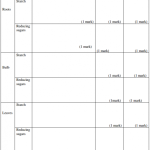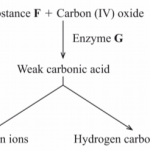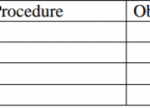KNEC KCSE Biology Paper 1 – 2014 KCSE COMA Joint Exam
2014 KCSE COMA Joint Exam
Biology Paper 1
Name the causative agent of cholera.
1 marks
The diagram below represents a cell organelle.
(a) Identify the organelle. (1 mark)
(b) Name the part labelled B. (1 mark)
(c) State the function of part labelled A. (1 mark)
3 marks
State the functions of the following parts of a light microscope.
(a) Condenser. (1mark)
(b) Diaphragm. (1 mark)
2 marks
(a) Explain three ways in which a red blood cell is adapted to its function. (3 marks)
(b) In which form is carbon (IV) oxide transported. (1 mark)
4 marks
State the functions of the following organelles.
(i) Centriole. (1 mark)
(ii) Nucleolus. (1 mark)
2 marks
The diagram below shows part of plant tissue.
(a) Name cell labelled X and part labelled W. (2 marks)
(b) State two adaptations of cell labelled X to its function.(2 marks)
4 marks
(a) Differentiate between hypogeal germination and epigeal germination. (2 marks)
(b) State two causes of dormancy in seed. (2 marks)
4 marks
(a) Define polyploidy. (1 mark)
(b) Name three disorders resulting from gene mutations. (3 marks)
4 marks
(a) Distinguish between homologous and analogous structure. (2 marks)
(b) Explain the term continental drift as used in evolution. (2 marks)
4 marks
The diagram below represents a sensory cell.
(a) Identify with a reason the type of neurone above. (1 mark)
Reason: (1 mark)
(b) Name parts labelled. (2 marks)
Q ____________________________________________________________________
Z ____________________________________________________________________
4 marks
(a) Name three supportive tissues in plants. (3 marks)
(b) Name the type of muscles found in the gut. (1 mark)
4 marks
A form one student trying to estimate the size of onion cells observed the following on the
microscope’s field of view.
(a) Define the term resolving power. (1 mark)
(b) If the student counted 20 cells across the field of view calculate the size of one cell in
micrometers. (2 marks)
3 marks
(a) Distinguish between transpiration and guttation. (2 marks)
(b) State two importance of guttation in hydrolytes. (2 marks)
4 marks
The diagram below shows the exchange of gases in alveolus.
(a) State how the alveoli are adapted to their function. (3 marks)
(b) Name the cell labelled A. (1 mark)
4 marks
(a) Distinguish between respiratory quotient and oxygen debt. (2 marks)
(b) Name the site where anaerobic respiration occurs in the cell. (1 mark)
3 marks
Study the graph below and answer the questions that follow.
(a) What is the name given to the type of graph? (1 mark)
(b) What is the name used to describe point X. (1 mark)
(c) State the importance of part X. (1 mark)
(d) Name the phylum in which the graph represented in above occurs. (1 mark)
4 marks
(a) Define the term natural selection. (1 mark)
(b) Name three evidence of organic evolution. (3 marks)
4 marks
State one adaptation of the following parts of mammalian eye.
(i) Fovea centralis. (1 mark)
(ii) Sclera. (1 mark)
(iii) Cilliary body. (1 mark)
3 marks
Name the cartilage found between vertebrae of the vertebral column.
1 marks
(a) Differentiate between gaseous exchange and ventilation. (2 marks)
(b) Name the respiratory sites of the following:
(i) Fish (1 mark)
(ii) Insects (1 mark)
4 marks
(a) Name two cardiovascular diseases. (2 marks)
(b) If the nerve supply to the heart of a mammal is severed the rythymic heart contraction
and relaxation will go on and heart continues to beat. Explain why. (2 marks)
4 marks
Name two major branches of Biology.
2 marks
(a) State the functions of the following apparatus.
(i) Bait trap. (1 mark)
(ii) Pooter. (1 mark)
2 marks
State two structural adaptations of veins to their function.
2 marks
Name the process that results to formation of tissue fluid.
1 marks
What is serum?
1 marks








